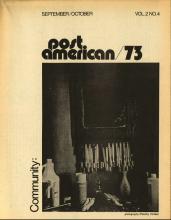Phase Four is now in effect, bringing with it a big increase in prices. It has caused almost everyone to seek ways to cut down on the amount of money spent. This need, plus our commitment to Christ and consequential opposition to consumerism, led to the inception of SIMPLICITY. In this regular feature, we want to suggest practical and creative alternatives (or, bluntly stated, this column is about how to save money and how to get around spending money altogether).
An easy way to produce food at home any time of year that is rich in vitamins and minerals and also very inexpensive is by sprouting. Mung beans are especially good for sprouting and have a generous supply of Vitamins A, B, C, and E plus many proteins and minerals. These nutrients are all encased in the seed and are what the embryonic plant exists on until its roots grow down into the soil. When the sprouts are four or five days old, they are at their highest level of nutritional development.
To sprout mung beans follow these steps:
1. Soak the beans in lukewarm water (one teaspoon of beans yields one cup of sprouts).
2. After twenty-four hours rinse them and place in a non-rusting container with drainage. I used a plastic cottage cheese carton, poking holes in the bottom with a red-hot pin for drainage.)
3. Keep the container covered and in a warm place for four days. Several times each day rinse with cool water. This will keep them damp and reduce the heat that is produced as they sprout.
4. Sprouts are ready to eat on the fifth day, after rinsing off the little green skins. They are good raw and in salads, and also can be used in cooking (the Chinese have been using them for thousands of years).
Read the Full Article

